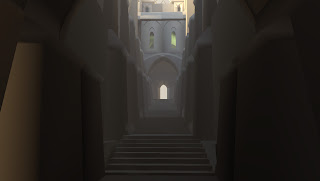Hi there,
Last post was about a test I did for Gameloft Romania. This time I'll post about another test I did right after the first one, for Cyanide.
I had to build a level inside UDK, with a small number of modular assets, in a gothic/medieval style, based upon the idea of verticality.
After one week working for Gameloft's Test, I received a mail from Cyanide. I had 8 to 10 days to complete their test from reception. As I had one week left to finish the first one, it seemed a bit tough to do both at the same time. xD
I asked for a delay. They agreed... but stayed very vague: 'as soon as possible' they said. In the end I did it in 5 days to send it by end of the week.
While Gameloft's test had a 3 page pdf explaining all the constraints and a very precise workflow to follow, Cyanide's Test was quite the opposite. No polycount limitation, just the constraint of doing 2 final assets amongst the modular assets of the map. Again, this was very different from any test I've done before, and by this way very interesting as well.
It was the first time I worked on modular 3d assets. It's basically the same as 2d, but there, UDK's snapping tools imply to work modules in a specific way. UDK has a specific unit system. I didn't want to take that into account while concepting my modules, to focus only on modularity inside 3ds max and had in mind scaling them to the right size for a believable scale inside UDK later on.
That was a mistake. Because snapping in UDK is working only on the grid and is easy to set for exponents of 2 (4, 8, 16, 32, 64, etc.) or low multiples of 64/128 and more units. Another mistake was doing modules working with 60/120° rotations, inspired by several patterns I found on Viollet le duc's medieval architecture's encyclopaedia. That was perfect in max, but was causing troubles in UDK due to the same snapping system. I ended using this hexagonal system only in one part of the level, but it didn't fit very well.
Last post was about a test I did for Gameloft Romania. This time I'll post about another test I did right after the first one, for Cyanide.
I had to build a level inside UDK, with a small number of modular assets, in a gothic/medieval style, based upon the idea of verticality.
After one week working for Gameloft's Test, I received a mail from Cyanide. I had 8 to 10 days to complete their test from reception. As I had one week left to finish the first one, it seemed a bit tough to do both at the same time. xD
I asked for a delay. They agreed... but stayed very vague: 'as soon as possible' they said. In the end I did it in 5 days to send it by end of the week.
While Gameloft's test had a 3 page pdf explaining all the constraints and a very precise workflow to follow, Cyanide's Test was quite the opposite. No polycount limitation, just the constraint of doing 2 final assets amongst the modular assets of the map. Again, this was very different from any test I've done before, and by this way very interesting as well.
It was the first time I worked on modular 3d assets. It's basically the same as 2d, but there, UDK's snapping tools imply to work modules in a specific way. UDK has a specific unit system. I didn't want to take that into account while concepting my modules, to focus only on modularity inside 3ds max and had in mind scaling them to the right size for a believable scale inside UDK later on.
That was a mistake. Because snapping in UDK is working only on the grid and is easy to set for exponents of 2 (4, 8, 16, 32, 64, etc.) or low multiples of 64/128 and more units. Another mistake was doing modules working with 60/120° rotations, inspired by several patterns I found on Viollet le duc's medieval architecture's encyclopaedia. That was perfect in max, but was causing troubles in UDK due to the same snapping system. I ended using this hexagonal system only in one part of the level, but it didn't fit very well.










No comments:
Post a Comment